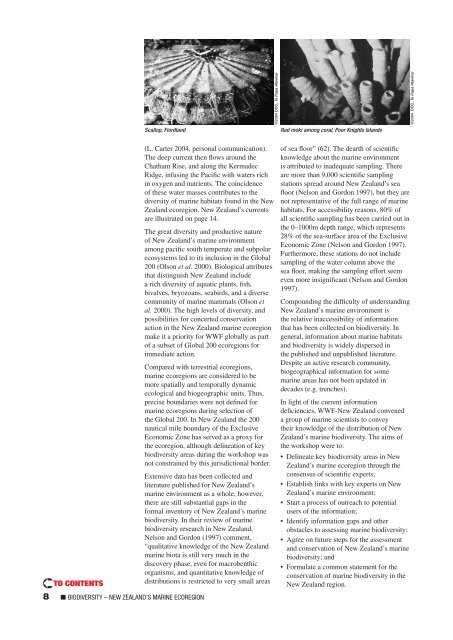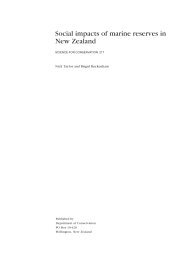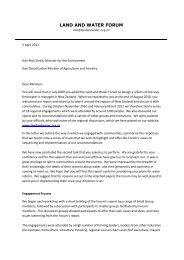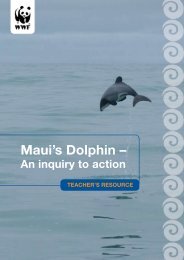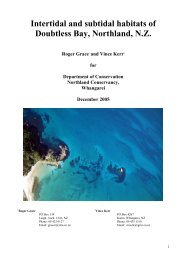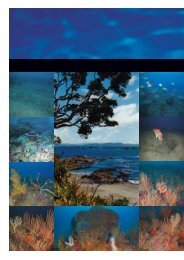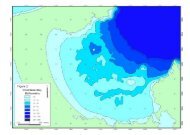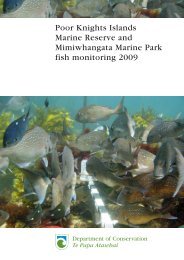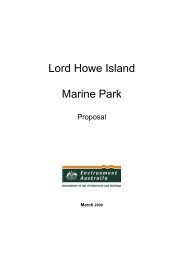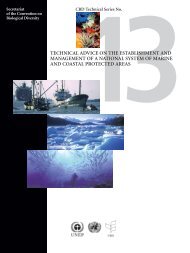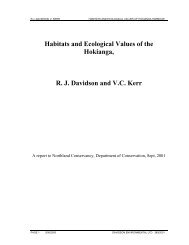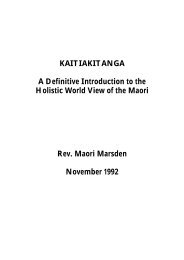WWF Shining a spotlight on the biodiversity of ... - MarineNZ.org.nz
WWF Shining a spotlight on the biodiversity of ... - MarineNZ.org.nz
WWF Shining a spotlight on the biodiversity of ... - MarineNZ.org.nz
Create successful ePaper yourself
Turn your PDF publications into a flip-book with our unique Google optimized e-Paper software.
Scallop, Fiordland<br />
©2004 DOC, Te Papa Atawhai<br />
Red moki am<strong>on</strong>g coral, Poor Knights Islands<br />
©2004 DOC, Te Papa Atawhai<br />
(L. Carter 2004, pers<strong>on</strong>al communicati<strong>on</strong>).<br />
The deep current <strong>the</strong>n flows around <strong>the</strong><br />
Chatham Rise, and al<strong>on</strong>g <strong>the</strong> Kermadec<br />
Ridge, infusing <strong>the</strong> Pacific with waters rich<br />
in oxygen and nutrients. The coincidence<br />
<strong>of</strong> <strong>the</strong>se water masses c<strong>on</strong>tributes to <strong>the</strong><br />
diversity <strong>of</strong> marine habitats found in <strong>the</strong> New<br />
Zealand ecoregi<strong>on</strong>. New Zealand’s currents<br />
are illustrated <strong>on</strong> page 14.<br />
The great diversity and productive nature<br />
<strong>of</strong> New Zealand’s marine envir<strong>on</strong>ment<br />
am<strong>on</strong>g pacific south temperate and subpolar<br />
ecosystems led to its inclusi<strong>on</strong> in <strong>the</strong> Global<br />
200 (Ols<strong>on</strong> et al. 2000). Biological attributes<br />
that distinguish New Zealand include<br />
a rich diversity <strong>of</strong> aquatic plants, fish,<br />
bivalves, bryozoans, seabirds, and a diverse<br />
community <strong>of</strong> marine mammals (Ols<strong>on</strong> et<br />
al. 2000). The high levels <strong>of</strong> diversity, and<br />
possibilities for c<strong>on</strong>certed c<strong>on</strong>servati<strong>on</strong><br />
acti<strong>on</strong> in <strong>the</strong> New Zealand marine ecoregi<strong>on</strong><br />
make it a priority for <str<strong>on</strong>g>WWF</str<strong>on</strong>g> globally as part<br />
<strong>of</strong> a subset <strong>of</strong> Global 200 ecoregi<strong>on</strong>s for<br />
immediate acti<strong>on</strong>.<br />
Compared with terrestrial ecoregi<strong>on</strong>s,<br />
marine ecoregi<strong>on</strong>s are c<strong>on</strong>sidered to be<br />
more spatially and temporally dynamic<br />
ecological and biogeographic units. Thus,<br />
precise boundaries were not defined for<br />
marine ecoregi<strong>on</strong>s during selecti<strong>on</strong> <strong>of</strong><br />
<strong>the</strong> Global 200. In New Zealand <strong>the</strong> 200<br />
nautical mile boundary <strong>of</strong> <strong>the</strong> Exclusive<br />
Ec<strong>on</strong>omic Z<strong>on</strong>e has served as a proxy for<br />
<strong>the</strong> ecoregi<strong>on</strong>, although delineati<strong>on</strong> <strong>of</strong> key<br />
<strong>biodiversity</strong> areas during <strong>the</strong> workshop was<br />
not c<strong>on</strong>strained by this jurisdicti<strong>on</strong>al border.<br />
Extensive data has been collected and<br />
literature published for New Zealand’s<br />
marine envir<strong>on</strong>ment as a whole, however,<br />
<strong>the</strong>re are still substantial gaps in <strong>the</strong><br />
formal inventory <strong>of</strong> New Zealand’s marine<br />
<strong>biodiversity</strong>. In <strong>the</strong>ir review <strong>of</strong> marine<br />
<strong>biodiversity</strong> research in New Zealand,<br />
Nels<strong>on</strong> and Gord<strong>on</strong> (1997) comment,<br />
“qualitative knowledge <strong>of</strong> <strong>the</strong> New Zealand<br />
marine biota is still very much in <strong>the</strong><br />
discovery phase, even for macrobenthic<br />
<strong>org</strong>anisms, and quantitative knowledge <strong>of</strong><br />
distributi<strong>on</strong>s is restricted to very small areas<br />
<strong>of</strong> sea floor” (62). The dearth <strong>of</strong> scientific<br />
knowledge about <strong>the</strong> marine envir<strong>on</strong>ment<br />
is attributed to inadequate sampling. There<br />
are more than 9,000 scientific sampling<br />
stati<strong>on</strong>s spread around New Zealand’s sea<br />
floor (Nels<strong>on</strong> and Gord<strong>on</strong> 1997), but <strong>the</strong>y are<br />
not representative <strong>of</strong> <strong>the</strong> full range <strong>of</strong> marine<br />
habitats. For accessibility reas<strong>on</strong>s, 80% <strong>of</strong><br />
all scientific sampling has been carried out in<br />
<strong>the</strong> 0–1000m depth range, which represents<br />
28% <strong>of</strong> <strong>the</strong> sea-surface area <strong>of</strong> <strong>the</strong> Exclusive<br />
Ec<strong>on</strong>omic Z<strong>on</strong>e (Nels<strong>on</strong> and Gord<strong>on</strong> 1997).<br />
Fur<strong>the</strong>rmore, <strong>the</strong>se stati<strong>on</strong>s do not include<br />
sampling <strong>of</strong> <strong>the</strong> water column above <strong>the</strong><br />
sea floor, making <strong>the</strong> sampling effort seem<br />
even more insignificant (Nels<strong>on</strong> and Gord<strong>on</strong><br />
1997).<br />
Compounding <strong>the</strong> difficulty <strong>of</strong> understanding<br />
New Zealand’s marine envir<strong>on</strong>ment is<br />
<strong>the</strong> relative inaccessibility <strong>of</strong> informati<strong>on</strong><br />
that has been collected <strong>on</strong> <strong>biodiversity</strong>. In<br />
general, informati<strong>on</strong> about marine habitats<br />
and <strong>biodiversity</strong> is widely dispersed in<br />
<strong>the</strong> published and unpublished literature.<br />
Despite an active research community,<br />
biogeographical informati<strong>on</strong> for some<br />
marine areas has not been updated in<br />
decades (e.g. trenches).<br />
In light <strong>of</strong> <strong>the</strong> current informati<strong>on</strong><br />
deficiencies, <str<strong>on</strong>g>WWF</str<strong>on</strong>g>-New Zealand c<strong>on</strong>vened<br />
a group <strong>of</strong> marine scientists to c<strong>on</strong>vey<br />
<strong>the</strong>ir knowledge <strong>of</strong> <strong>the</strong> distributi<strong>on</strong> <strong>of</strong> New<br />
Zealand’s marine <strong>biodiversity</strong>. The aims <strong>of</strong><br />
<strong>the</strong> workshop were to:<br />
• Delineate key <strong>biodiversity</strong> areas in New<br />
Zealand’s marine ecoregi<strong>on</strong> through <strong>the</strong><br />
c<strong>on</strong>sensus <strong>of</strong> scientific experts;<br />
• Establish links with key experts <strong>on</strong> New<br />
Zealand’s marine envir<strong>on</strong>ment;<br />
• Start a process <strong>of</strong> outreach to potential<br />
users <strong>of</strong> <strong>the</strong> informati<strong>on</strong>;<br />
• Identify informati<strong>on</strong> gaps and o<strong>the</strong>r<br />
obstacles to assessing marine <strong>biodiversity</strong>;<br />
• Agree <strong>on</strong> future steps for <strong>the</strong> assessment<br />
and c<strong>on</strong>servati<strong>on</strong> <strong>of</strong> New Zealand’s marine<br />
<strong>biodiversity</strong>; and<br />
• Formulate a comm<strong>on</strong> statement for <strong>the</strong><br />
c<strong>on</strong>servati<strong>on</strong> <strong>of</strong> marine <strong>biodiversity</strong> in <strong>the</strong><br />
New Zealand regi<strong>on</strong>.<br />
8 ■ BIODIVERSITY – NEW ZEALAND’S MARINE ECOREGION


